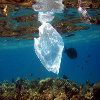Animal Deaths are Rubbish

Several western civilizations live in a disposable society were products are purchased, used, and thrown in the garbage. The side effect to this lifestyle is an excessive amount of non-biodegradable litter. As product waste increases with larger human populations, available landfill space shrinks. In an attempt to resolve the issue in a way that does not impede consumerism, rubbish is tossed into the oceans.
The most notable is the Great Pacific Garbage Patch, which is the largest dump-site in the world. This garbage island exists because of how currents in the Pacific Ocean converge, gathering trash dumped into the water from around the world. It is speculated that its mass is double the size of the United States or Australia. Though accurate measurements for the size of this garbage island are rudimentary, the quantities of contaminants are not. Ninety percent of the debris is comprised of plastic. While ships at sea certainly contribute to the trash buildup, 80 percent of what is dumped into the water originates from the land and not ships.
Even with all of the recycling programs, the dumping of non-biodegradable junk into the oceans averages 200 billion pounds (90,800,000 metric tons) each year. The United Nations Environment Program estimates that for every square mile of water there are 46,000 pieces of plastic. This amount of plastic in the water supersedes the weight of natural organisms found within the same square mile by a ratio of 6:1. Therefore, as this debris sinks it is able to decimate plankton life forms, which are the building blocks of aquatic life and the key to water vitality. In addition to the Great Pacific Garbage Patch, there are four other similar locations around the world forming these trash islands because of the natural convergence of currents.
The animals whose survival depends on sustainable water face physical hazards in addition to a decrease in food supplies. Fishnets cut free rather than pulled into a boat ensnare cetaceans, fish, reptiles, and waterfowl causing strangulation or drowning. Aquatic residents view shredded or small sized colorful plastic pieces as food because it resembles plankton, fish eggs, and krill. This results in either death or toxic contamination, which then spreads up the food chain.
Each year the death toll exceeds one million animals from debris exposure. Between chemical dumps, oil spills, oil drilling, overfishing, and garbage islands humans put animals into a losing battle. Ironically, with their destruction so befalls the equivalent outcome for humankind. This begs the question: Why are people engaging in a war with nature when it results in the demise of their species?
For those interested in ideas on productive waste management and to take action, visit Protect Animals From Garbage Islands Initiative.
The most notable is the Great Pacific Garbage Patch, which is the largest dump-site in the world. This garbage island exists because of how currents in the Pacific Ocean converge, gathering trash dumped into the water from around the world. It is speculated that its mass is double the size of the United States or Australia. Though accurate measurements for the size of this garbage island are rudimentary, the quantities of contaminants are not. Ninety percent of the debris is comprised of plastic. While ships at sea certainly contribute to the trash buildup, 80 percent of what is dumped into the water originates from the land and not ships.
Even with all of the recycling programs, the dumping of non-biodegradable junk into the oceans averages 200 billion pounds (90,800,000 metric tons) each year. The United Nations Environment Program estimates that for every square mile of water there are 46,000 pieces of plastic. This amount of plastic in the water supersedes the weight of natural organisms found within the same square mile by a ratio of 6:1. Therefore, as this debris sinks it is able to decimate plankton life forms, which are the building blocks of aquatic life and the key to water vitality. In addition to the Great Pacific Garbage Patch, there are four other similar locations around the world forming these trash islands because of the natural convergence of currents.
The animals whose survival depends on sustainable water face physical hazards in addition to a decrease in food supplies. Fishnets cut free rather than pulled into a boat ensnare cetaceans, fish, reptiles, and waterfowl causing strangulation or drowning. Aquatic residents view shredded or small sized colorful plastic pieces as food because it resembles plankton, fish eggs, and krill. This results in either death or toxic contamination, which then spreads up the food chain.
Each year the death toll exceeds one million animals from debris exposure. Between chemical dumps, oil spills, oil drilling, overfishing, and garbage islands humans put animals into a losing battle. Ironically, with their destruction so befalls the equivalent outcome for humankind. This begs the question: Why are people engaging in a war with nature when it results in the demise of their species?
For those interested in ideas on productive waste management and to take action, visit Protect Animals From Garbage Islands Initiative.
You Should Also Read:
Clean Water for Healthy Animals
Tar Sands Extraction Mutates Animal Life
Fossil Fuels Affect Core Aquatic Life

Related Articles
Editor's Picks Articles
Top Ten Articles
Previous Features
Site Map
Follow @WildlifeWelfare
Tweet
Content copyright © 2023 by Deb Duxbury. All rights reserved.
This content was written by Deb Duxbury. If you wish to use this content in any manner, you need written permission. Contact Deb Duxbury for details.







